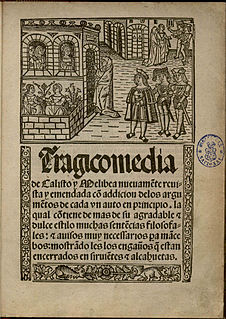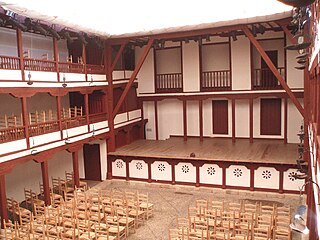
Pedro Calderón de la Barca y Barreda González de Henao Ruiz de Blasco y Riaño, usually referred as Pedro Calderón de la Barca, was a dramatist, poet and writer of the Spanish Golden Age. During certain periods of his life he was also a soldier and a Roman Catholic priest. Born when the Spanish Golden Age theatre was being defined by Lope de Vega, he developed it further, his work being regarded as the culmination of the Spanish Baroque theatre. As such, he is regarded as one of Spain's foremost dramatists and one of the finest playwrights of world literature.

Francisco Balagtas, also known as Francisco Baltazar, was a prominent Filipino poet, and is widely considered one of the greatest Filipino literary laureates for his impact on Filipino literature. The famous epic Florante at Laura is regarded as his defining work.

The Comedy of Calisto and Melibea, known in Spain as La Celestina is a work entirely in dialogue published in 1499. It is attributed to Fernando de Rojas, a descendant of converted Jews, who practiced law and, later in life, served as an alderman of Talavera de la Reina, an important commercial center near Toledo.

Giulia Daysi Gam is an Italian-born Brazilian actress.

Juan de la Cueva de Garoza (1543–1612) was a Spanish dramatist and poet. He was born in Seville to an aristocratic family; his younger brother Claudio, with whom he spent some time in Guadalajara, Mexico, went on to become an archdeacon and inquisitor. He was acquainted with a number of major contemporary intellectual figures, including Fernando de Herrera and Juan de Mal Lara, and took part in the Casa de Pilatos literary academy in Seville. After his return to Spain in 1577, he began writing for the stage and produced a total of ten comedies and four tragedies. He appears never to have married, though some of his poetical works are dedicated to a Felipa de la Paz. After apparently spending some time in Cuenca after 1610, he died in Granada in 1612.

Luís Fernando Veríssimo is a Brazilian writer. Verissimo is the son of Brazilian writer Erico Verissimo and lived with his father in the United States during his childhood. Best known for his crônicas and texts of humor, more precisely satire of manners, published daily in several Brazilian newspapers, Verissimo is also a cartoonist, translator, and television writer, playwright and novelist. He has also been advertising and newspaper copy desk. He is also a musician, having played saxophone in a few sets. With over 60 published titles, is one of the most popular contemporary Brazilian writers.
José de Cañizares y Suárez was a Spanish playwright. Cavalry officer, public official, and author of around one hundred works, he was one of the most important dramatists of the early 18th century.
A loa is a short theatrical piece, a prologue, written to introduce plays of the Spanish Golden Age or Siglo de Oro during the 16th and 17th centuries. These plays included comedias and autos sacramentales. The main purposes for the loa included initially capturing the interest of the audience, pleading for their attention throughout the play, and setting the mood for the rest of the performance. This Spanish prologue is specifically characterized by praise and laudatory language for various people and places, often the royal court for example, to introduce the full-length play. The loa was also popular with Latin American or "New World" playwrights during the 17th and 18th centuries through Spanish colonization.

Olga Zubarry was a classic Argentine actress who appeared in film between 1943 and 1997. She made over 60 appearances in film, spanning 6 decades of Argentine cinema, but is best known for her work during the Golden Age of Argentine Cinema. Throughout the course of her career, she received four Silver Condor Awards, two Martín Fierro Awards, a Konex Foundation Award and several others for her films and television performances. She is credited with starring in the first film in Argentina which featured nudity, though only her back was shown and she stated repeatedly that she wore a flesh-colored mesh and was not truly nude.

Alexis Valdés is a Cuban actor, comedian, monologist, film producer, singer and screenwriter. He was born in Havana, Cuba, on August 16, 1963.
Nora Salinas is a Mexican actress and former model. She has appeared in numerous soap operas, several plays and film "Cicatrices" for which she won a "Diosa de Plata" award as New Actress.

God's Comedy is a 1995 Portuguese film by João César Monteiro. It is the second part in a trilogy, preceded by Recordações da Casa Amarela (1989) and followed by As Bodas de Deus (1999). God is symbolized through the character João de Deus, played by writer/director Monteiro himself. The film was selected as the Portuguese entry for the Best Foreign Language Film at the 68th Academy Awards, but was not accepted as a nominee.

Cross-gender acting refers to actors or actresses portraying a character of the opposite gender.
Fenisa’s Hook is a play written by the Spanish playwright Lope de Vega. It was first published in 1617 in the eighth part of Lope de Vega’s Comedias. Based on the tenth tale of the eighth day of Boccaccio’s Decameron, it has been called a picaresque play, works that exhibit an uncharacteristic moral freedom Boccaccio’s tale is about a trickster who is tricked Lope uses Boccaccio’s story for the main plot of his play, where Fenisa, a courtesan in Palermo attempts to woo the rich merchant Lucindo in order to gain his riches. A secondary plot includes Dinarda who is dressed as a man and has come to Palermo in search of the man who seduced her and left her behind. Fenisa ends up falling for this Dinarda who is disguised as don Juan de Lara. While Fenisa is able to trick Lucindo the first time around, he comes back to Sicily a second time and this time he tricks her. In the end, Dinarda finds and marries her Albano, while Fenisa is left without a spouse and without money.

Antonio de Zamora was a Spanish playwright.

Corral de comedias, literally a "theatrical courtyard", is a type of open-air theatre specific to Spain. In Spanish all secular plays were called comedias, which embraced three genres: tragedy, drama, and comedy itself. During the Spanish Golden Age, corrals became popular sites for theatrical presentations in the early 16th century, when the theater took on a special importance in the country. The performance was held in the afternoon and lasted two to three hours, there being no intermission, and few breaks. The entertainment was continuous, including complete shows with parts sung and danced. All spectators were placed according to their sex and social status.
The Steel of Madrid is a 1608 play by the Spanish writer Lope de Vega, famous for his contributions to the 'Spanish Golden Age of literature.

Las 13 esposas de Wilson Fernández is a Mexican black comedy web television series that premiered on May 12, 2017, on Blim. Based on the Argentine series of the same name produced in 2014. It stars Martín Altomaro as the titular character.

3 familias, is a Mexican telenovela produced by Joshua Mintz and Ana Celia Urquidi for TV Azteca. It is an adaptation for Mexico of the Ecuadorian series of the same name. It premiered on October 23, 2017 and ended on May 25, 2018. It stars Íngrid Martz as the titular character. The production of the telenovela officially began on September 11, 2017.

Giulliana Rocha de Barros Rego, better known as Giulli Succine, is a Brazilian actress and psychologist. He began his career at the age of 11 in the theater with the play O Cinema e a Dança. Already in the television participated in programs like Rebelde, Milagres de Jesus and Sol Nascente. His last works in the theater were in Noite da Comédia Improvisada and O Rio e Grande Elenco in 2018. She is a cousin of the journalist Luca Moreira.


















